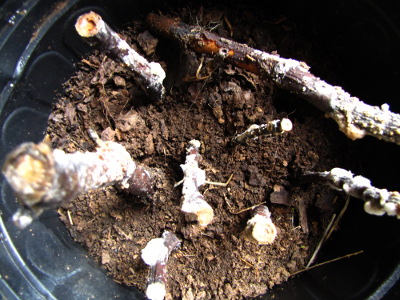
Fig cutting failure
 Well, I now know two methods
of rooting fig cuttings that definitely don't work for me --- in
a ziplock bag on top of a heat pad and in a pot of soil on top
of a heat pad. The fungal growth is pretty impressive, but the
cuttings are obviously dead.
Well, I now know two methods
of rooting fig cuttings that definitely don't work for me --- in
a ziplock bag on top of a heat pad and in a pot of soil on top
of a heat pad. The fungal growth is pretty impressive, but the
cuttings are obviously dead.
Actually, I suspect the
problem started even before I began trying to root the cuttings.
I had to cut the young wood before it was 100% dormant because a hard
freeze was coming and I needed to wrap
up the tree.
Perhaps the branches were too high in sugars (thus the fungal growth)
since they weren't fully asleep yet?
All is not lost.
Three little sprouts rooted the easy way, right at the feet of the
parent plant, and I have two
in my garden and one
in Mom's garden waiting for spring. Since there really is a limit
to how much space I have for fig trees, I suspect this propagation
method will do the trick. I'd still like to learn to root
cuttings just for geekiness sake, but I'm not too heartbroken over this
round of failures.
Want more in-depth information? Browse through our books.
Or explore more posts by date or by subject.
About us: Anna Hess and Mark Hamilton spent over a decade living self-sufficiently in the mountains of Virginia before moving north to start over from scratch in the foothills of Ohio. They've experimented with permaculture, no-till gardening, trailersteading, home-based microbusinesses and much more, writing about their adventures in both blogs and books.
Want to be notified when new comments are posted on this page? Click on the RSS button after you add a comment to subscribe to the comment feed, or simply check the box beside "email replies to me" while writing your comment.

Hi Anna,
Considering that many (all?) animal and human diseases are 'cured' by adding deficient minerals and other substances to their diet, I wonder if adding the 'right' mineral mix to your soil might cure the transplant problem?
Maybe try a range of various mixes and additives like granite dust ,seawater, animal manure, etc. in different pots to see what works and what doesn't.
For an interesting read about really improving plant health, see Julius Hensel's "Bread from stones".
John
John --- While I agree that minerals in the soil are very important, I doubt they're the issue this time around. The fig cuttings didn't put out any roots at all, so the only way soil minerals could have affected rooting would be if the parent tree were deficient, not if my potting soil was deficient.
(I suspect you'll love next week's lunchtime series, though, because I'm going to talk about soil analysis in great, great depth. )
)
Hi Anna,
It WILL be a very interesting and important discussion.
Different soil consultants recommend different quantities of the various minerals in their ideal soil. The most informed will follow the minerals into the plants and on into the animals. And will probably be into hair trace mineral analysis of their animals and humans.
For example iodine, the cancer mineral, passes through plants without modifying their growth. So you can't tell what is in a given plant unless you have the plant measured. There is one iodine accumulator plant family. Brown seaweed - kelp and kombu.
I suspect this is why 'seaweed' is a popular soil addition. Plants so fertilized make people feel better :).
If you look at germanium and the lanthanide series elements you will find some of the more informed consultants talking about them.
Do look at bread from stones if you haven't. I got it free from Steve Solomon's soilandhealth.org internet library.
Lots of fun :).
John